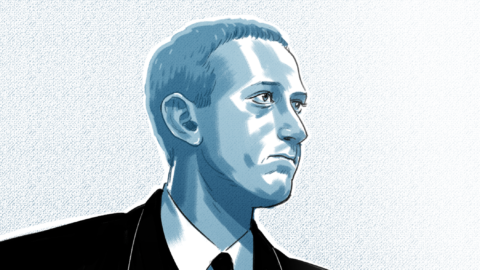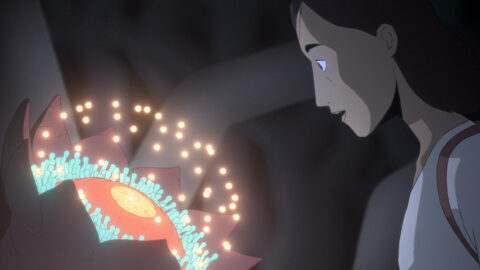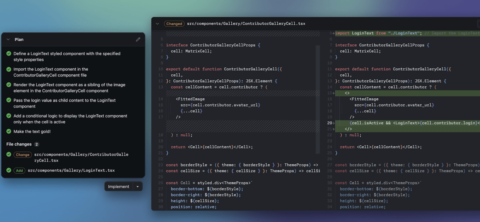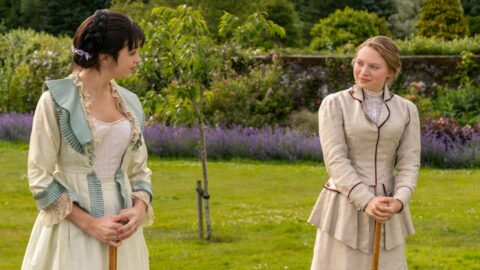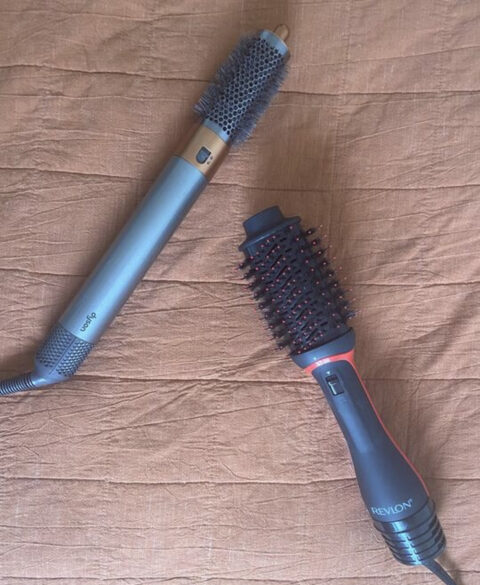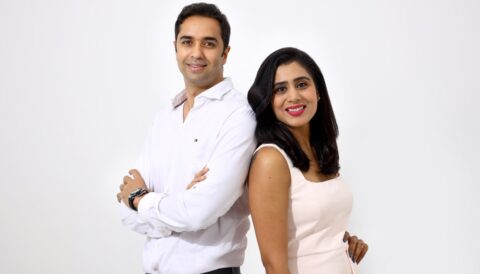The iconic, internet-famous Dyson Airwrap is $600. We tested it out to see who should actually be dropping the cash on it.

UPDATE: Nov. 7, 2023, 5:00 a.m. EST We’ve updated this review after testing out the Dyson Airwrap Complete Long Diffuse.
The thing about the Dyson Airwrap is, for a hair styler that’s $600, I expected it to perform some miracles.
It’s not even the price tag alone that built that expectation for me. The countless TikToks, YouTube videos, and its near-constant sold out status made me believe Dyson hit hair gold.
Then, considering I’m reviewing the updated iteration of the Dyson Airwrap that launched in June 2022, I imagined I’d be using an improved version of what already seemed to be a well-liked product worth the hype. And I love my Dyson vacuum, so my hopes were pretty high.
As it turns out, the Dyson Airwrap Complete multi-styler is just fine.
I’m not here to stir up a controversy or fish for hate clicks, but I’d be lying if I said that after using the Airwrap (and its many dupes), I don’t really understand why people act like this is The Hair Tool missing from their life (outside of course, than the confirmation bias of the TikToks, YouTube videos, and constant sold out status that seem to tell us constantly that this is The Hair Tool missing from our lives).
Don’t get me wrong, it’s an innovative and impressive hair tool that has clearly influenced the beauty tech space — I just don’t think you need to pay $600 to get the results it gives. I do think a lot of the Dyson Airwrap’s worth lies in what you want out of a styler, and what your hair is brings to the party sans heat and air styling.
When the Airwrap first dropped, I tested every single attachment over the course of a few weeks, and more recently I’ve tested the newer attachments from the Dyson Airwrap Complete Diffuse — so let’s get into the details.
What’s the difference between the Dyson Airwrap Complete and the original Airwrap?
In June 2022, Dyson released their second generation of the Airwrap, with a few upgrades.
The Coanda air tech (this is the fancy term that describes how the tool relies on air rather than heat to style) stuck around, but with some new attachments meant to optimize its use.
This updated iteration came in three models when it launched in 2022: the Dyson Airwrap Complete for short- to medium-length hair, the Dyson Airwrap Complete Long for hair that’s chest-length or longer (this is the model I tested), and the Dyson Airwrap Complete Coily/Curly for those with curly hair — as of Oct. 2022, this last model has been replaced by the Dyson Airwrap Complete Diffuse, which has a crucial new attachment (if you can guess from the name).
Dyson Complete Long attachments
The Complete Long comes with six attachments:
-
Coanda smoothing dryer
-
1.2-inch Airwrap long barrel
-
1.6-inch Airwrap long barrel
-
Firm smoothing brush
-
Soft smoothing brush
-
Round volumizing brush
All of these attachments come in a large storage case just like the original Airwrap. Mine lived on the floor next to my desk during the duration of my testing, since my bathroom simply did not have the space to accommodate it.
Where I stored my Dyson Airwrap case, with IKEA drawers for size reference.
Credit: Bethany Allard / Mashable
The new Dyson Airwrap Complete Diffuse
Finally, the Dyson Airwrap comes with a diffuser, allowing people with wavy and curly hair to dry to actually dry their hair (without losing their texture). Say hello to the Dyson Airwrap Complete Long Diffuse, which retails for $599.99.
Credit: Bethany Allard / Mashable
The Airwrap Diffuse is the exact same Airwrap, with a different selection of attachments. Here’s what’s included (brand new attachments are bolded):
-
Diffuser
-
Large round volumizing brush
-
Coanda smoothing dryer
-
Wide tooth comb
-
Firm smoothing brush
-
1.2-inch Airwrap long barrel
The addition of a diffuser to Dyson’s lineup finally puts some pressure on the Shark FlexStyle (which is hands down the best Airwrap dupe), which had a diffuser in its original lineup when it was released last fall. The Dyson diffuser does have a fairly large circumference — since I’ve initially tested the Airwrap, I’ve chopped off my hair to my shoulders, so I was worried this larger diffuser could prove difficult to use.
Turns out, it doesn’t at all. The diffuser snaps on perfectly to the base, and sits at an easy-to-maneuver angle. It helped me achieve definition to my 2A/2B waves, and noticeably more volume than when I rely on an air dry. I tested this diffuser with different styling products (a mouse one time and a styling cream another), and both times it delivered. What ended up being my biggest gripe with the diffuser’s size is that it doesn’t fit into the storage case alongside the rest of the attachments.
The diffuser helped me get more definition and noticeably more volume than my air dried hair.
Credit: Bethany Allard / Mashable
Though I do think the FlexStyle’s diffuser is a bit more versatile, with adjustable length prongs and the swiveling base, Dyson did a solid job with what it came up with. If you don’t want to buy an entirely new Airwrap, the brand will be selling the diffuser separately soon for $39.99.
The Airwrap Diffuse also comes with a new large volumizing brush, which is sold separately for $39.99. Though it’s not leaps and bounds away from other Dyson round brushes (or any round brush for that matter), the larger size is welcome.
With the original round brush, which has about a 1.5-inch diameter, I could get nice bouncy ends, but had more trouble achieving noticeable volume at the root, which isn’t an issue I’ve encountered when using larger round brushes.
The new Dyson large volumizing brush (left) and the round volumizing brush (right).
Credit: Bethany Allard / Mashable
The Dyson large volumizing brush, on the other hand, has a 2.2-inch diameter. It’s definitely targeted toward people with longer and thicker hair. As my hair currently sits on the shorter side, it’s hard for me to test effectively, but the bristles feel exactly the same as the smaller brush, which moved through my hair with ease.
The biggest attachment upgrades
When it comes to what’s noticeably improved from the first generation, the attachments are by far the standouts.
Direction changing curling barrels
Maybe the most obvious flaw of the first generation Airwrap was that to alternate the direction of your curls, you had to swap out your barrel, which meant if you didn’t want perfectly uniform curls, you’d have to use two barrels while styling.
The new Airwrap provides a fix in the form of a switch at the tip of both the 1.2-inch and 1.6-inch barrels, which allows you to change the curl direction with a simple twist of the very top of the barrel. Originally, I thought having to switch the barrels would ruin any convenience factor they offered, but after testing the Shark FlexStyle, it turns out having a barrel for each direction isn’t all that annoying.
For those of us without patience, Dyson provided a crucial fix on the curling attachment.
Credit: Bethany Allard / Mashable
Still, if you have the first gen Airwrap, use the curling barrels most days, and have $39.99 to spare, buying the newest barrels separately is likely worth it for you. For those with long hair, you’ll also likely appreciate the greater surface area of the “long” style barrel.
The dual purpose smoothing dryer attachment
The Coanda smoothing dryer was my sleeper hit of the updated Airwrap. While one end blows out a surprising amount of hot air for an overall dry, a quick twist redirects the air out of the smoothing end, which tames frizz as it dries and grabs sections of hair similar to the curling wand attachments. It actually worked great for smoothing sans any brushing, and it would dry my very long hair in 10 to 15 minutes. It’s a definite step up from the pre-styling dryer that came with the first Airwrap.
The new Dyson Airwrap smoothing attachment (left) replaces the pre-dry attachment (right) of the first generation Airwrap.
Credit: Mashable Photo Composite / Dyson
There are also some slight design changes on the smoothing brushes, but nothing as significant as the above two attachments.
If you already own the first generation Airwrap and want of the upgraded attachments, each is available (when in stock at least) for $39.99.
And as you would expect from a tool that costs this much, all the attachments snap into place easily and feel snug and firm when in use.
Still, the Dyson Airwrap learning curve isn’t nonexistent
When I first tested the Revlon One-Step (the original Airwrap dupe), I found it relatively easy to use, despite my middling hair styling skills. I expected much of the same with the Airwrap, especially since it’s seen as superior to the One-Step.
This held true when it came to every attachment but the curling barrels. The TikToks lied to you. It doesn’t just grab the ends of your hair, easy-peasy, no matter where hair is sitting. I found that it was really important to grab the right sized section of hair, hold out it out from the rest of my head so the barrel didn’t grab any extra hair, then let the ends hang limp so the styler would actually grab it.
Once I figured that out, it became much easier, but finding the right tension and sized section (which can be tricky with longer hair), takes some skill.
The curling attachment left much to be desired during and after the styling process
Before we even get into it, I want to be clear — I read the literature (Dyson’s help guides), I delved into the texts (YouTube tutorials), I assembled my most trusted confidants (heat protectant, styling cream, and hair spray) — I could not get the curls from the Dyson Airwrap to last in my hair for a full calendar day.
Maybe this could be forgiven in some cases, but styling these curls takes a good chunk of time, especially if you have longer and thicker hair. The first time I used the 1.6-inch curling barrel, I took 30 minutes to curl my hair, and this was after the six minutes it took to bring my hair from towel dried to the 80 percent damp state that’s recommended for curling the hair.
I read the literature (Dyson’s help guides), I delved into the texts (YouTube tutorials), I assembled my most trusted confidants (heat protectant, styling cream, and hair spray) — I could not get the curls from the Dyson Airwrap to last in my hair for a full calendar day.
That doesn’t sound bad, but then I realized a decent chunk of curls had fallen while I’d been curling. So I went back in, and about 20 minutes later, it looked somewhat better. Overall, I spent about an hour in my bathroom, and a few hours later when I drove to a friend’s birthday dinner, I realized the curls had mostly fallen. I had bouncy, flippy hair that was pretty, but not the loose waves I wanted.

1.6-inch barrel curls immediately after being styled.
Credit: Bethany Allard / Mashable

1.6-inch barrel curls about 4 and 1/2 hours later, in glorious car-selfie lighting.
Credit: Bethany Allard / Mashable
I decided that although the 1.6-inch barrel says it can achieve loose curls and waves, maybe for my hair, it would create more of a blowout-esque look. So, I turned to the 1.2-inch barrel. Again, I dutifully followed the steps Dyson recommends for curls: I sectioned my hair, blasted it with hot air for 10 to 15 seconds, then blasted it with cold air for an additional five to 10. I even did 20 to 25 seconds of hot air and 15 of cold, but my patience once again got in the way, and it didn’t make too much of a difference in the end anyway.

1.2-inch barrel curls immediately after styling, giving some bottom-heavy volume realness.
Credit: Bethany Allard / Mashable

Two hours later, these curls had fallen into very soft waves, with the middle of the hair straightening almost completely.
Credit: Bethany Allard / Mashable
Don’t expect curls that’ll last all day
While I eventually got to the place where this process moved a bit faster, the curls still fell while I styled and continued to fall throughout the day. Forgoing hairspray (which I can sometimes do with a curling wand) wasn’t an option if I wanted my style to last beyond an hour or two.
In fact, I found that styling one side, hair spraying it, then moving on to the other was key for longevity.
Some people say that they can get the curls to last for more than one day — even with a classic wand frying my hair, this isn’t possible for me, so I never had this expectation. However, watching the curls fall within the 45 minutes it took to style them — not once did I have to brush out even the most coiled Founding Father-esque curl — was a bit disappointing.

After much more practice, I was able to achieve prettier and more consistent curls.
Credit: Bethany Allard / Mashable

But 30 minutes after styling, they had already started to fall slightly. By night time, only a slight wave remained.
Credit: Bethany Allard / Mashable
As a fun experiment, my roommate also tested the curling barrel on freshly washed and 80 percent dried hair. Her hair, though incredibly straight, is happy to curl (and stay curled for multiple days) with a flat iron. Her hair is even longer than mine though, so she did struggle some to get it to wrap around the barrel at first. By the end of the experiment, her hair was pretty much straight again. For both of us, we found that our long hair meant that the curls, even when intact, were pretty bottom heavy, too.
My roommate ended up re-curling her hair with a curling wand after her first attempt with the 1.6-inch barrel yielded these results.
Credit: Bethany Allard / Mashable
One of the big draws you see about the Airwrap is the curling attachments, and they were certainly what I was most excited to try. Maybe it is just a matter of them not loving my hair type, or that I still have some learning to do, but in any case, they were by far the most disappointing part of the Dyson.
Hair-friendly heat styling is possible
I know we just spent some time going over why the curling barrel was less than great, but what I will say was a huge plus, is that even through hour-long styling sessions, my hair never felt like it was taking on all that much heat damage.
Not once did I smell that signature singed hair scent that accompanies the use of pretty much any hot tool, including the Revlon One-Step. This was true for every single attachment included with the Airwrap, which made me see why someone who regularly uses hot tools would want to pay to protect their hair a bit more. Sure, it might mean certain styles are locked in less, but for long term use, I definitely see the merit.
The Dyson also has great customizability when it comes to how much heat you want blasting your hair. In addition to the cool shot switch, there are three different heat levels, and three different air speed levels. All were easy to adjust mid-styling.
The heat and air settings are easy to adjust mid-styling.
Credit: Bethany Allard / Mashable
As an added bonus, every single time I styled my hair with this product, I got compliments, which is an especially nice feeling for someone who used to struggle brushing their hair when they were a kid.
The smoothing power is unreal
Since my hair runs a little on the dry side, I’m no stranger to frizz. Though I’ve never been a fan of completely straightened styles on myself, and therefore usually let my waves air dry, I actually found myself most happy with my results when using any of the smoothing attachments.
I’ve already spoken some about the new Coanda smoothing dryer, which was great for getting a quick, rough dry and flipping around to smooth out some frizz on the top of my head.
The attachments that surprised me the most with how much I liked them, especially since they looked the most boring, were the soft and firm smoothing brushes. Both are meant for straightening, but the firm brush has less flexible bristles meant to tame frizz a bit better. I used that one on the top layer of my hair where I get most frizzy, and the soft one for the rest of my head. By the end of styling, the frizz wasn’t nonexistent, but it was way less than what I usually deal with.
The two attachments that took me by surprise, the soft and firm smoothing brush (pictured left to right).
Credit: Bethany Allard / Mashable
In both cases, they actually worked as well normal brushes, too. I never ran a comb through my hair beforehand, as I would with a round brush, and my tangles came out easily.
What was also nice was that though I could get my hair perfectly straight, I could also brush through the very ends of my hair quicker to get it dry, but leave some of my natural wave. That gave me a look my roommate described as “styled, but like you didn’t style it at all,” which is ultimately the Peak Goal of quick styling. And I do mean quick, since these brushes dried my hair in 10 minutes. Overall, it gave much more body and movement than a standard hair straightener.

My hair went from towel dried to this in under 15 minutes thanks to the smoothing brushes.
Credit: Bethany Allard / Mashable

The smoothing brushes tamed my frizz and gave me great volume at the root.
Credit: Bethany Allard / Mashable
The attachment we’ve yet to talk about is the round volumizing brush. It’s pretty standard, not too large, and does provide pretty flips at the end of the hair. As for the volume it provides at the root, I honestly got better results with the smoothing brushes somehow. This could be a learning curve thing, but it was also easier on early passes with the Revlon One-Step to get bigger volume due to the larger brush size, though the One-Step definitely introduces more heat damage.
The Revlon One Step Plus round brush by far has the larger diameter.
Credit: Bethany Allard / Mashable
Again, if you’re a fan of a bigger volumizing brush, it’s probably worth it to invest in the new large volumizing brush that came out with the Airwrap Diffuse.
Is the Dyson Airwrap worth it?
On value alone, for most people, the Dyson Airwrap is probably not worth it. There are honestly too many good dupes out there to earnestly recommend this multi-styler as the only way to achieve the styles (and protection) it offers.
If you already own the first generation Airwrap, you 100 percent do not need to upgrade. If you want some of the benefits of the newer model, grab a couple of new attachments, but save your money — you’ve already made the big investment.
In other cases, it depends. If you occasionally want a blowout look, the Revlon One-Step or Amika blowout babe thermal brush are fantastic and a fraction of the cost. Yes, you’ll pay a bit with heat damage, but if you’re not using it super frequently, it’ll be okay.
If you just want great curls on some days, this might be a skip for you, too. Honestly, every time I curled my hair with the Airwrap, I thought about how much I would prefer using a Dyson blow dryer and then my classic curling wand, to achieve better results in less time.
With that said, I could see this working great for people with shoulder length or shorter hair. The styling time would be cut in half, and the curls would probably take up more of the strand. As someone who’s had shorter hair, I also know that some form of daily styling is usually necessary, so the plus of less damage isn’t negligible.
If you are heat styling your hair every single day, this product could very well be worth it. The other important thing to note is that the Airwrap works best when you style from wet hair, so if you’re not a morning shower-er, that’s another big point to consider. It could just mean making a lifestyle change, but I’m personally a nighttime shower person at the end of the day (literally!), so I didn’t love having to rewet my hair every morning.
It is, first and foremost, a luxury
For everybody else, unless you’re really dying to spend $600, you don’t need the Airwrap. It’s fancy, it’s fun, but you shouldn’t expect (like I did) that it’s going to drastically change your hair game. And if you’re looking for an incredibly similar, and in certain cases superior, experience at a lower price point, the Shark FlexStyle is a great option.
Now that we have a diffuser, what I’d personally love to see the most from the Airwrap — and this is straight out of Shark’s playbook — is a build your own kit. With Shark’s kit, it comes with fewer attachments (three compared to four), but you choose exactly which attachments you want — and the whole package costs less overall. Imagine if Dyson pretended a budget-conscious audience existed! (But I guess, considering the Airwrap’s frequently sold out status, they don’t have to).
Ultimately, the Airwrap has some huge benefits, but the hefty price tag, time investment, and issues with the curling attachment kept it from completely blowing me away.

